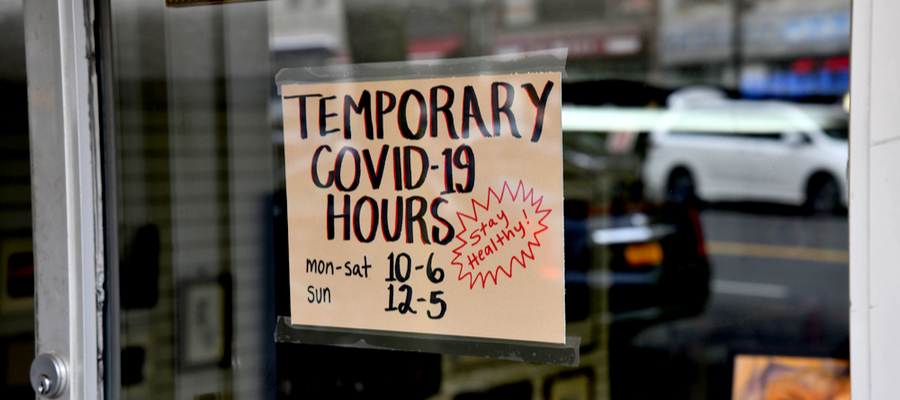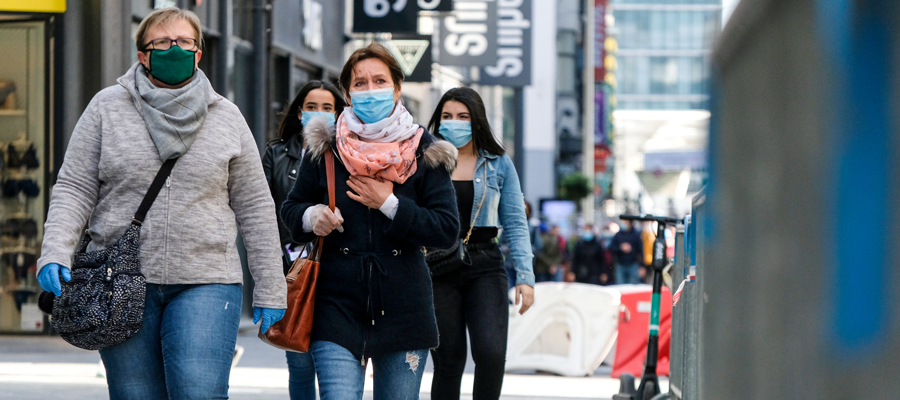Comparing provincial economic responses to COVID-19

The COVID-19 pandemic has highlighted the vital importance of collective responses via governments at all levels. The Canadian context of federalism, with a division of powers between federal and provincial/territorial governments, also highlights key differences in approaches to the pandemic.
At its best, federalism is an advantageous arrangement, with the federal government addressing national issues, funding certain income transfers to households, and fiscal transfers to provinces and territories in support of public services, in particular health care and post-secondary education.
In a federal system, provinces can tailor services and programs to meet their specific regional or industrial needs, but a strong federal presence raises the floor relative to what we would expect from the provinces if each acted on their own. Federal policy can also ensure consistency in access to key services across the country—as we have done through Medicare.
In the COVID-19 economic response, the federal government has done most of the heavy lifting, as is fitting given its stronger fiscal capacity, and its expenditures are backed by the Bank of Canada (see Jim Stanford on the Bank’s quantitative easing operations).
Key federal economic supports include the Canada Emergency Wage Subsidy (or CEWS, which pays 75 per cent of wages to employers that keep workers on payroll, with a maximum of $847 per week per worker) and the Canada Emergency Response Benefit (or CERB, which pays $500 per week directly to individuals who have lost income due to COVID-19). It has also boosted child benefits and the low-income GST credit payment, while providing liquidity by deferring tax payments and creating loan and credit programs for small businesses. A number of specialized supports for Indigenous communities, NGOs and charities, and vulnerable populations have also been announced.
In the COVID-19 economic response, the federal government has done most of the heavy lifting, as is fitting given its stronger fiscal capacity, and its expenditures are backed by the Bank of Canada
This post looks at provincial/territorial economic responses on top of the federal supports (although the response in the territories has been fairly limited). What follows is not intended to be a comprehensive inventory of all provincial measures, but it highlights the major initiatives and key differences across provinces.
Our assessment finds that provincial and territorial governments overall are doing comparably little in terms of economic response (but, of course, have the lead on the public health response), although BC is the clear leader in terms of addressing gaps for the unemployed, renters and vulnerable populations. The differences among provinces and the gaps revealed below indicate a greater role for the federal government to go further in raising the floor to ensure high standards and levels of support across the country.
So how do the provinces compare?
Income Support
Several provinces (such as Alberta, Saskatchewan, Quebec and New Brunswick) implemented their own worker support programs in mid-March, before the federal response was clear, but these have now been eliminated in favour of the federal CEWS and CERB programs.
BC and Nova Scotia have both added a $1,000 one-time top-up to the CERB, although the Nova Scotia version is aimed only at low-income workers (less than $34,000 in annual income). In addition, BC boosted its low-income Climate Action Tax Credit (one-time, to be paid in July 2020) by $174.50 per adult and $51 per child. In addition, BC seniors receiving the Seniors’ Supplement will receive an additional $300 per month for three months.
Ontario is also providing additional payments to seniors and children. Low-income seniors in Ontario receiving benefits from the Guaranteed Annual Income System will see payment doubled to a maximum of $166 per month for individuals and $332 per month for couples, for six months as of April 2020. Ontario families with children will receive a one-time $200 payment per child up to 12 years of age, and $250 for those with special needs.
Social assistance is an area where all provinces have failed to provide for the basic needs of their most vulnerable people prior to COVID-19.
Provincial actions differ widely in regards to people on welfare incomes during the pandemic. BC is the only province that will not claw back the CERB from income assistance recipients who are also eligible for the federal benefit. Ontario is part way on this and will allow working recipients to keep just over half ($1,100) of any CERB income in addition to income assistance. However, in Nova Scotia, for example, any income assistance recipient who qualifies for the CERB will no longer receive income assistance (but they will continue to receive pharmacare benefits).
For those who cannot access the CERB, BC is increasing its benefits for income and disability assistance by $300 per month (for three months). One-time income and disability assistance top-ups have been implemented in Ontario (up to $100 for individuals and $200 for families), and Nova Scotia ($50 per person) and the Northwest Territories ($500 for a single recipient, or $1,000 for households with two or more people).
For businesses, most provinces have deferred payments of various business taxes and fees to improve their cash flow situation
A stronger federal role–such as allowing all people on income assistance to access the CERB–would raise the bar substantially in the fight against poverty across the country. Social assistance is an area where all provinces have failed to provide for the basic needs of their most vulnerable people prior to COVID-19.
For businesses, most provinces have deferred payments of various business taxes and fees to improve their cash flow situation. In BC, for example, this includes the Employer Health Tax, Provincial Sales Tax, carbon tax, fuel tax and tobacco taxes until the Fall. Saskatchwan, Alberta, Nova Scotia, and Ontario are allowing employers to defer payment of workers’ compensation premiums.
Some other notable business support measures:
- The BC government is aiming for a 25 per cent reduction in the total property tax bill, including a 50 per cent reduction in the provincial portion of property tax.
- Saskatchewan and Nova Scotia have both set up a one-time grant for small and medium size businesses directly affected by COVID-19 (up to 15 per cent of sales revenue from sales, and a maximum of $5,000).
- New Brunswick is offering working capital loans to companies and has created a small investment fund for non-profits adversely affected by the pandemic.
- Alberta has reversed a 3.4 per cent increase in property taxes introduced in its previous budget.
Essential Workers
While many workers are facing a loss of work and income, others are vital to the functioning of society, especially the public health response. Most provinces are working to ensure child care is available for those who have been deemed “essential workers,” in some cases at no charge (Quebec, Newfoundland and Labrador). BC child care providers that stay open are receiving enhanced funding to keep operations going, and the government is expected to cover approximately 75 per cent of a group facility’s average monthly operating expenses (seven times the usual amount).
Most provinces are working to ensure child care is available for those who have been deemed “essential workers,”
BC’s moves to improve the wages and conditions for workers in long-term care facilities are notable. The BC government has issued a “single-site” order that requires all workers in long-term care and assisted living (including those with contracted and sub-contracted operators) to work at only one site in order to prevent the spread of the virus. The province has also required that all workers be paid the unionized industry standard wage rate and committed to full-time hours.
Alberta has introduced a $2 per hour wage top-up for health-care aides, and up to 1,000 paid student practicum positions to fast-track certification for work in continuing care facilities. Quebec has also introduced wage increases for health care workers. Those with direct contact to the virus have been given an 8 per cent wage increase, while other workers get a 4 per cent increase, and workers in private long-term care an additional $4 per hour.
BC’s moves to improve the wages and conditions for workers in long-term care facilities are notable.
Other essential workers include health care support roles like janitorial or food service, grocery store workers, and public transit workers, who remain exposed to extra risk during this time. To protect bus drivers, BC has made bus travel free in Metro Vancouver via TransLink (fares still required for Skytrain and Seabus) and the rest of BC Transit operations across the province. Edmonton Transit has also suspended all fares for buses and Light Rail Transit.
Housing
The plight of renters who have lost income due to COVID-19 is top of mind because renter households tend to be lower-income and have fewer assets than homeowners. According to surveys of landlords by CIBC Economics, about 75 per cent of tenants paid April rent in full, another 10 per cent paid roughly half, and 15 per cent did not pay at all. Since the economic shutdown did not start in earnest until mid-March, the prospects for renters on May 1 look grim without a more coherent support plan.
Most provinces have suspended evictions due to COVID-19-related reasons during the pandemic. Manitoba has only postponed non-urgent eviction hearings until May 31, while PEI has only only suspended eviction orders in private rental housing until the courts can resume regular operations. In Alberta the eviction ban ends April 30, and in New Brunswick May 31. BC has additionally suspended annual rent increases for the duration of the pandemic.
Who bears the burden of missed rent is a key question: some fair allocation of missed rent should be paid by landlords and banks, rather than fall fully on renters. The gist of the eviction bans is that rent is deferred but not cancelled, so renters may breathe a sigh of relief until the pandemic is over, but then are expected to pay accumulated back rent—or presumably face eviction.
Who bears the burden of missed rent is a key question: some fair allocation of missed rent should be paid by landlords and banks, rather than fall fully on renters.
Compared to the federal response on income support, housing is an example of detrimental provincial divergence on policy. BC and PEI are the only provinces to take actions to financially support renters, and even there the measures have been rather modest. BC’s Temporary Renter Supplement will pay directly to landlords $300 per month (for four months) for eligible households without dependents and $500 per month for those with dependents. PEI’s Temporary Rental Assistance Benefit will provide $1,000 per household to help cover the cost of rent for a three-month period ($500 for the first month, $250 for each subsequent month).
A more coherent federal role is clearly required to support renters or homeowners whose payments are threatened by a loss of income. The feds have instructed banks to work with homeowners on mortgage deferrals and relief, but this is voluntary and favours the banks, which can charge interest during the deferral period. No province has brought in additional provisions in regards to mortgages and related deferrals. The federal government is now developing a program in support of commercial renters, and a similar effort should be extended to residential renters as well.
Compared to the federal response on income support, housing is an example of detrimental provincial divergence on policy.
Homeless people have also fallen through the cracks of the public health and economic response to varying degrees. BC notably opened up 939 new spaces across 21 sites (including a Vancouver hotel) for homeless people who need to self-isolate and people with COVID-19 who need a place to recover after being discharged from the hospital. Manitoba has opened up 140 new shelter spaces, and Saskatchewan is also providing a small number of hotel rooms or social housing units to individuals experiencing homelessness. At the municipal level, the City of Toronto has been acquiring hotels, motels and rental buildings to house homeless people, and the City of Montreal has opened additional shelters and is providing additional resources for homeless people. A strong federal role is recommended to ensure everyone has a roof over their heads, during the pandemic and after.
Utilities
BC Hydro reduced its rates by 1 per cent and is providing a one-time credit equivalent to three months of BC Hydro electricity consumption for residential customers who have lost income due to COVID-19 (approximately $135 in savings for the average apartment and $335 for the average single-family home). Residential and commercial customers can defer their payments with no penalty, and qualifying small businesses can also have three months of charges waived.
Ontario is supporting lower Hydro rates and is dropping time-of-use pricing to the lowest tier during the pandemic. Also, it is expanding eligibility for the province’s Low‑income Energy Assistance Program (LEAP) and ensuring that electricity and natural gas services are not disconnected for nonpayment during the COVID‑19 outbreak.
Other provinces are showing some flexibility. Disconnections for non-payment have been stopped in most provinces. Alberta residential and commercial customers can defer electricity and natural gas bill payments until June 2020. Manitoba Hydro says they’ll work with customers who are unable to pay their bills. Nova Scotia Hydro is relaxing timelines for bill payments for residential customers, and waiving late fees for 90 days.
Other measures
An essential role for provincial/territorial governments is in supporting vulnerable populations. Nova Scotia has rolled out $1.4 million in funding for support of vulnerable adults, food security and transition houses.
Ontario is providing $200 million in new funding to provide temporary emergency support for people in financial need as well as funding to municipalities and other service providers to respond to local needs, including food banks, homeless shelters, churches and emergency services. Ontario is also boosting funding by more than $2.7 million to support victims of domestic violence and other violent crimes.
BC is funding $50 million in seniors’ supports through community service agencies around the province. BC also added $5 million toward the expansion of existing mental health programs and virtual services, and $3 million for food banks. The province is moving forward with a plan to provide safe drug supply to confront the opioid crisis, and the federal government has removed its previous objections.
There is little to point to in terms of provinces supporting Indigenous people and communities, with the notable exception of Ontario
All provinces have implemented deferrals on student loan payments until the fall. BC is also providing some additional emergency financial aid for students ($3.5 million plus $1.5 million for Indigenous students).
There is little to point to in terms of provinces supporting Indigenous people and communities, with the notable exception of Ontario, which is paying an additional $26 million, including “emergency assistance for urban Indigenous people in financial need, costs for health care professionals and critical supplies to reach remote First Nations, as well as funding to address emergency planning and self‑isolation needs for people in First Nation communities.”
A stronger federal role should also consider local governments and regional transit agencies. Municipalities in BC can temporarily tap their capital reserves to support operating expenditures during the pandemic, and will have additional capacity to borrow for that purpose (normally, municipal governments must balance their budgets). The BC and Alberta governments have also deferred remittance of provincial property taxes collected on its behalf by municipal governments. These measures, while helpful, fall short of providing operating grants to support key municipal public services, or allowing local governments access to the federal wage subsidy program.
Conclusion
All provinces have imposed moratoria on evictions, ensured child care capacity for essential workers and paused student loan payments. However, there are important differences across provinces that are highlighted by the COVID-19 economic responses.
Smaller provincial governments have much less fiscal capacity and typically higher pre-pandemic debt-to-GDP ratios. So it is no surprise they have largely left the economic response to the federal government, with only minor additional measures.
In some cases, such as Manitoba, ill-advised austerity is already underway with the provincial government seeking budget cuts in the public sector. This points to looming fiscal challenges for provinces as Canada emerges from the current moment with a larger collective debt load. Responding to this debt load with provincial austerity measures would be detrimental for the recovery and could severely undermine essential public services.
Responding to this debt load with provincial austerity measures would be detrimental for the recovery and could severely undermine essential public services.
Across the board, BC is leading the nation with its economic response to COVID-19. There are still gaps in coverage, which we hope will be addressed in the weeks ahead, but BC’s additions to income and housing supports are cushioning the blow of the COVID-19 recession, and numerous smaller measures have been advanced to help specific groups. Other provinces should consider developing a more robust package of supports along the lines of BC. To a lesser extent Ontario has provided specialized funding for vulnerable populations and extra support for Indigenous people and communities.
The challenges and gaps at the provincial level point to the need for further federal action in key areas to improve conditions across the country. This could be the case for addressing homelessness, income support for people on social assistance, rent and mortgage deferrals and cancellation, and support for municipal and regional governments. In each of these areas the federal government can close gaps in coverage, reduce inequality among people and provinces, and ensure everyone a bridge to the other side of the pandemic.
Topics: COVID-19, Economy, Employment & labour, Housing & homelessness, Poverty, inequality & welfare, Provincial budget & finance



